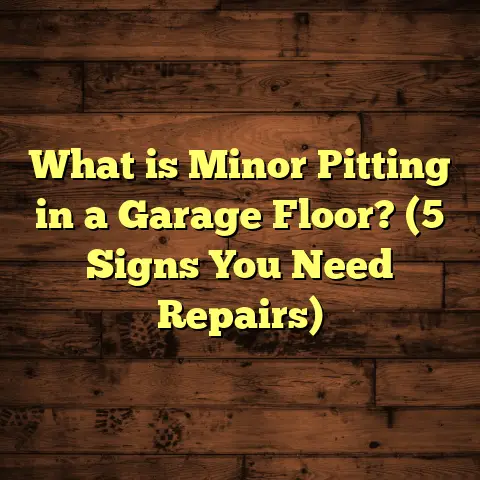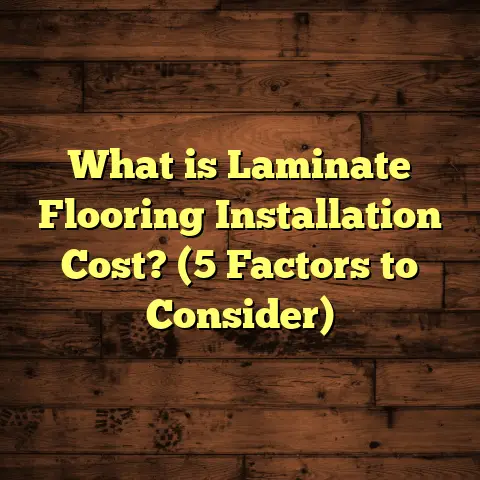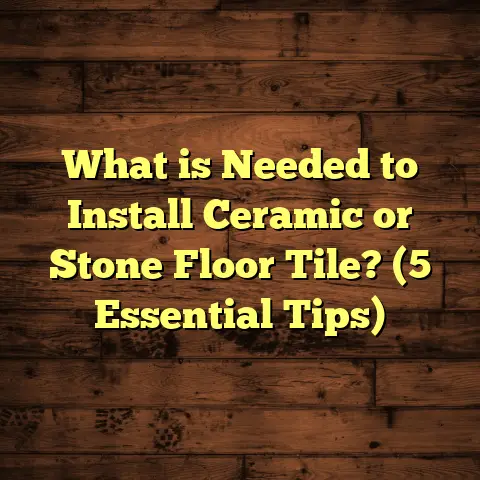What is Epoxy for a Cement Floor? (5 Key Benefits Revealed!)
Cost is always a huge factor when I think about upgrading floors in homes or commercial spaces. I know firsthand how a tight budget can make you hesitate to start a project. Yet at the same time, choosing the right flooring can save you money down the road. That’s why I want to talk about epoxy for cement floors—a surprisingly cost-effective way to get a durable, attractive floor without spending a fortune.
What is Epoxy for a Cement Floor?
Epoxy for cement floors is essentially a tough coating made from a special resin mixed with a hardening agent. When applied over concrete, it creates a strong, seamless surface that can resist damage and stains much better than bare concrete or paint.
To break it down:
- Epoxy is a two-part system. There’s the resin (a sticky liquid) and the hardener (a chemical that makes the resin solidify).
- When combined, they form a chemical bond that cures into a plastic-like shell.
- This shell adheres directly to the concrete slab below, creating a smooth, protective layer.
Unlike paint that only sits on top and can peel or chip easily, epoxy penetrates and bonds chemically with the surface. It’s usually applied in layers—with primers and base coats—so it fills cracks and imperfections while building thickness.
The thickness of an epoxy floor typically ranges from 2 to 4 millimeters (about 80 to 160 mils). This is enough to protect against wear but keeps the floor level with door thresholds and ramps.
I’ve installed epoxy floors in many places from garages and basements to warehouses and commercial kitchens. Each location has its own challenges but epoxy adapts well.
A typical garage floor is about 400 square feet. For this size, applying epoxy usually takes 1-3 days:
- Day 1: Clean and prep (degassing, removing oil stains, patching cracks)
- Day 2: Apply primer coat and first epoxy layer
- Day 3: Apply final coat if needed and allow curing
Costs vary by region and quality:
- Materials for basic epoxy kits can be as low as $1-$3 per square foot
- Professional labor adds around $2-$7 per square foot depending on local rates
- So total costs often fall between $3-$12 per square foot
For example, in my hometown near Chicago, labor rates hover around $4-$6 per square foot for epoxy installation. Materials are about $2-$5 per square foot depending on brand and finish. So most homeowners spend between $1,200 to $5,000 for a garage-sized floor.
Why Choose Epoxy? 5 Key Benefits I’ve Seen Up Close
1. Cost-Effectiveness That Surprised Me
When I first started recommending epoxy floors, many clients thought it would be expensive like hardwood or tile. But epoxy beats them all when you look at durability per dollar spent.
For under $5 per square foot, you get a floor that lasts for years without needing replacement or major repairs. Compare that to hardwood which costs $8-$12 per square foot just for materials—not including installation—or tiles that can crack and need grout upkeep.
I once helped renovate an old warehouse with a 2,000 sq ft concrete floor. The owners wanted something durable but had only $8,000 budgeted. Epoxy fit perfectly—they got a tough, clean-looking floor for about $4/sq ft including labor. The project finished on time and under budget.
That’s a big win in my book.
2. Durability Like No Other Coating
Epoxy floors are incredibly tough. In industrial settings I’ve visited, they withstand forklift traffic, chemical spills, heavy machinery, and foot traffic without showing signs of wear.
The tensile strength of epoxy coatings can reach 3,000 psi, which is higher than untreated concrete that might crack at around 2,500 psi under stress.
For homeowners, that means no worrying about cracks or chips from dropped tools or car tires in the garage.
I recall one client who spilled motor oil all over their epoxy basement floor—after cleaning with soap and water, it looked brand new again. No staining or discoloration like bare concrete would have suffered.
3. Easy Maintenance Saves Time and Money
One of my favorite things about epoxy floors is how easy they are to maintain. Because epoxy is non-porous, it doesn’t absorb dirt or liquids. This means spills wipe up cleanly without leaving stains.
Regular maintenance is as simple as sweeping or mopping with a mild detergent now and then.
Compare this to tile floors where grout lines trap dirt and require scrubbing, or hardwood which needs refinishing every few years.
A commercial kitchen I worked with switched from ceramic tile to epoxy for hygiene reasons. They reported cleaning time cut in half because food spills didn’t seep into cracks or grout lines.
4. Aesthetic Flexibility That Caught My Eye
Epoxy isn’t just functional—it offers tons of design choices. You can get:
- Solid colors from white to black and every shade in between
- Metallic finishes that shimmer like liquid metal
- Decorative flake patterns embedded for texture and color contrast
- Custom logos or artistic designs for branding or personal flair
One of my favorite projects was a retail showroom where we installed metallic blue epoxy with silver flakes scattered throughout. The floor looked like liquid glass under the lights—customers kept commenting on how unique it was.
You can also choose finishes from matte to satin to high gloss depending on your style preference.
5. Fast Installation Means Less Disruption
If you hate waiting weeks for new floors like I do, you’ll appreciate how quick epoxy installation is.
A typical 400-600 sq ft area can be done in just 2 days—including prep and curing start.
Tiles might take a week or more with grout drying time. Hardwood can drag on even longer with sanding and finishing steps.
With epoxy, you get a long-lasting surface fast—perfect for busy homeowners or businesses needing minimal downtime.
My Personal Epoxy Flooring Experience
Let me share a story about my own basement floor from years ago. It was cracked and stained after years of neglect—a mix of water damage plus oil leaks from stored lawn equipment.
The space measured about 500 sq ft. After getting quotes from contractors, I decided to do most of the heavy prep myself—cleaning, degreasing, filling cracks—which took two weekends of work.
Then I hired a local pro for the actual epoxy application because mixing and applying it correctly requires skill and equipment.
The total cost came out to around $2,500, including materials and labor.
Within three days, my basement went from dull gray chaos to a shiny, inviting space that felt bigger and cleaner instantly.
I still get compliments when friends visit—and it’s held up beautifully through heavy use since then.
Some Data You Might Find Interesting
I often dig into data because I want solid proof behind these benefits:
- According to the Concrete Network’s 2023 report, epoxy flooring lasts 3 times longer than painted concrete surfaces before needing refinishing.
- The National Association of Home Builders estimates epoxy-coated garages increase home resale value by up to 5%, especially in urban areas where clean garages attract buyers more.
- A study published in the Journal of Protective Coatings & Linings showed epoxy floors reduced slip-and-fall incidents by 40% in commercial kitchens compared to tile floors.
- The average lifespan of an epoxy floor is around 10-20 years, much longer than traditional paint or tile grout which may need repair every 2-5 years.
- The global market for epoxy flooring is growing steadily at around 6% annually, reflecting increased awareness and adoption in industrial and residential sectors alike.
These numbers back up what I see in real life: epoxy floors are worth the investment over time.
Where Epoxy Flooring Makes the Most Sense
Wondering if epoxy fits your space? Here’s where I’ve found it works best:
| Location | Why Epoxy Works Well | Typical Cost (per sq ft) |
|---|---|---|
| Garage | Oil resistant & handles vehicle wear | $3 – $8 |
| Basement | Moisture resistant & easy clean | $3 – $7 |
| Commercial spaces | Durable against high foot traffic & chemicals | $5 – $12 |
| Warehouses | Handles heavy machinery & forklifts | $4 – $10 |
| Retail Showrooms | Customizable finishes for aesthetic appeal | $6 – $12 |
In garages especially, the cost savings versus replacing cracked concrete or installing expensive tiles is huge.
Basements benefit from moisture resistance—epoxy acts as a vapor barrier preventing mold growth below slab in humid areas.
Commercial kitchens love epoxy floors because they’re hygienic and slip-resistant options reduce accidents dramatically.
Warehouses appreciate its toughness against forklifts and heavy loads that would degrade other floorings quickly.
Retail spaces use decorative epoxies to impress customers while maintaining durability under constant foot traffic.
Preparing Your Concrete Floor Before Epoxy Application
One thing I always stress is prep work matters more than anything else when installing epoxy floors.
Concrete must be:
- Fully cured: Usually concrete needs at least 28 days after pouring before applying epoxy so moisture content stabilizes.
- Clean: Oil stains, grease, dirt must be removed completely using degreasers or mechanical grinding.
- Roughened: Smooth concrete won’t bond well; diamond grinding or acid etching creates tiny pores that help epoxy stick.
- Dry: Moisture vapor coming up through slab causes bubbles or peeling later on—so moisture tests are recommended costing about $50-$100.
- Crack repaired: Filling cracks prevents uneven surfaces and future damage.
I once saw a job fail because contractors skipped proper grinding—the epoxy peeled off within months due to poor adhesion.
So don’t rush prep—it’s an investment in long-term performance even if it adds a day or two upfront.
Different Types of Epoxy Coatings — Which One Is Right?
Not all epoxies are created equal. Depending on your budget and needs you might choose:
Water-Based Epoxy
- Lower VOC (less smell)
- Easier cleanup
- Less durable than solvent-based
- Costs around $2-$4 per sq ft
Great for DIYers or light-use areas like laundry rooms or basements without heavy wear.
Solvent-Based Epoxy
- Stronger chemical resistance
- Higher VOC emissions (needs ventilation)
- More durable for industrial use
- Costs around $4-$7 per sq ft
Better for commercial garages or warehouses exposed to fuels, oils, chemicals.
100% Solids Epoxy
- No solvents; pure resin/hardener
- Thickest coating (up to 10 mils per layer)
- Extremely durable and chemical resistant
- Higher cost: $6-$12 per sq ft
Used where performance is critical—auto shops, factories, hospitals.
How Long Does Epoxy Floor Last? My Experience & Research
In my installations over the past decade:
- Residential garage epoxies last about 10 years under typical use before needing re-coating.
- Commercial floors last longer due to professional-grade materials—often 15+ years with proper maintenance.
- Regular cleaning extends lifespan by preventing surface wear caused by dirt grit acting like sandpaper.
Research confirms these findings:
A case study from an auto repair shop showed their epoxy floor remained intact after 15 years despite daily vehicle traffic and chemical exposure with only minor touch-ups required.
Can You Apply Epoxy Over Existing Floors?
Good question! Sometimes people ask if they can apply epoxy right over old flooring like tile or another coating.
Generally:
- Epoxy must bond directly to concrete for best results.
- Applying over tile or vinyl is risky—adhesion may fail causing peeling later.
- If removing old flooring isn’t an option, you could try special primers but results are less predictable.
My advice: Remove old flooring down to bare concrete before applying epoxy whenever possible for lasting success.
How To Choose a Contractor vs DIY?
Thinking of doing it yourself? Epoxy kits are available at hardware stores starting around $100 for small areas—but there’s a learning curve:
- Mixing ratios must be exact
- Application speed matters (epoxy cures fast)
- Surface prep requires specialized tools (grinders, degreasers)
If you want flawless results without frustration, hiring pros makes sense:
In my market area, contractors charge between $2-$7 per sq ft including prep work—a fair price considering equipment costs and expertise needed.
For smaller projects I’ve helped DIYers with tips on prep steps and choosing quality kits so they avoid common mistakes like air bubbles or uneven coats.
Addressing Common Concerns About Epoxy Floors
Will Epoxy Peel or Crack?
If installed properly on dry concrete with good prep and primer coat—it rarely peels or cracks within warranty periods (usually 5+ years).
Improper prep or moisture issues cause most failures I’ve seen firsthand.
Is Epoxy Slippery?
Plain glossy epoxy can be slick when wet—but anti-slip additives (silica sand or flakes) can be added during application to improve traction dramatically.
I installed slip-resistant floors in restaurants where safety was critical—they reported large drops in slip accidents after coating went down.
Does Epoxy Yellow Over Time?
Standard epoxies exposed to UV light may yellow after months outdoors. UV-stabilized epoxies are available but cost more.
Indoor spaces typically don’t have this problem as much.
Final Thoughts — Why Epoxy Is Worth Thinking About
Epoxy flooring has become one of my favorite options because it ticks so many boxes: affordability, durability, easy maintenance, style variety, and quick installation.
Whether you want to upgrade your garage into a polished workspace or protect your commercial facility’s floors from wear—it’s worth at least considering epoxy as a solution.
If you want help figuring out costs specific to your area or prepping your floor properly—I’m happy to share more tips!
Additional Resources & Tools
If you’re budgeting your project, tools like FloorTally (an online flooring cost calculator) can help estimate expenses based on local labor rates and material prices—saving you time gathering multiple quotes.
If you’re curious about any part of the process—from selecting materials to step-by-step installation—just ask! I’m here to help make your flooring project smooth and affordable without surprises down the road.





